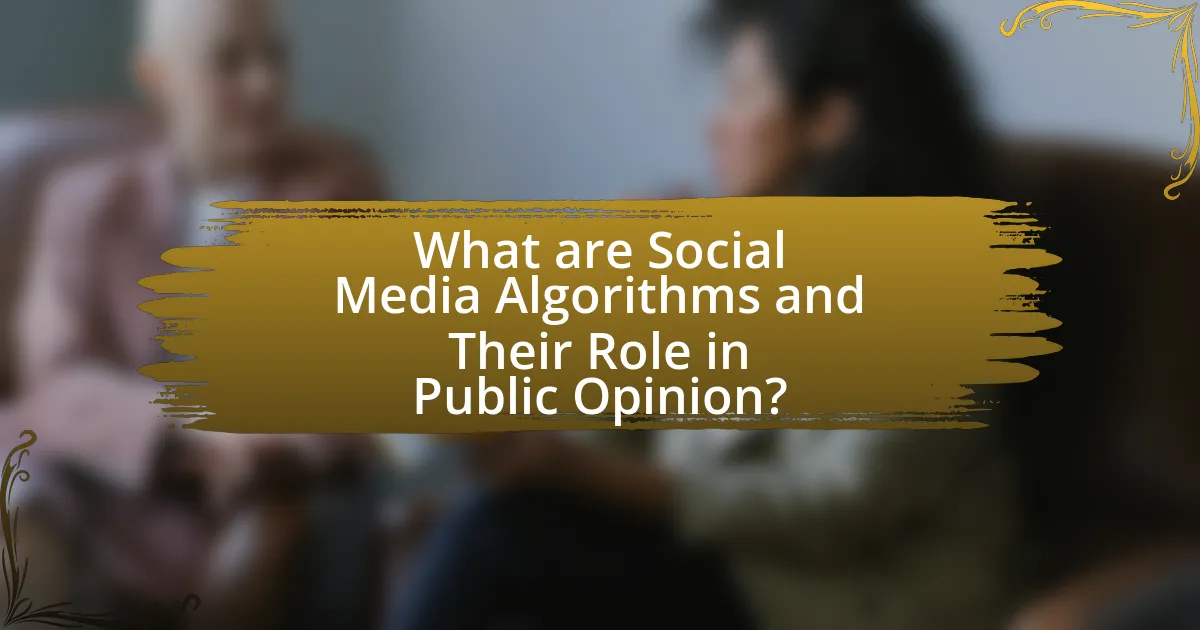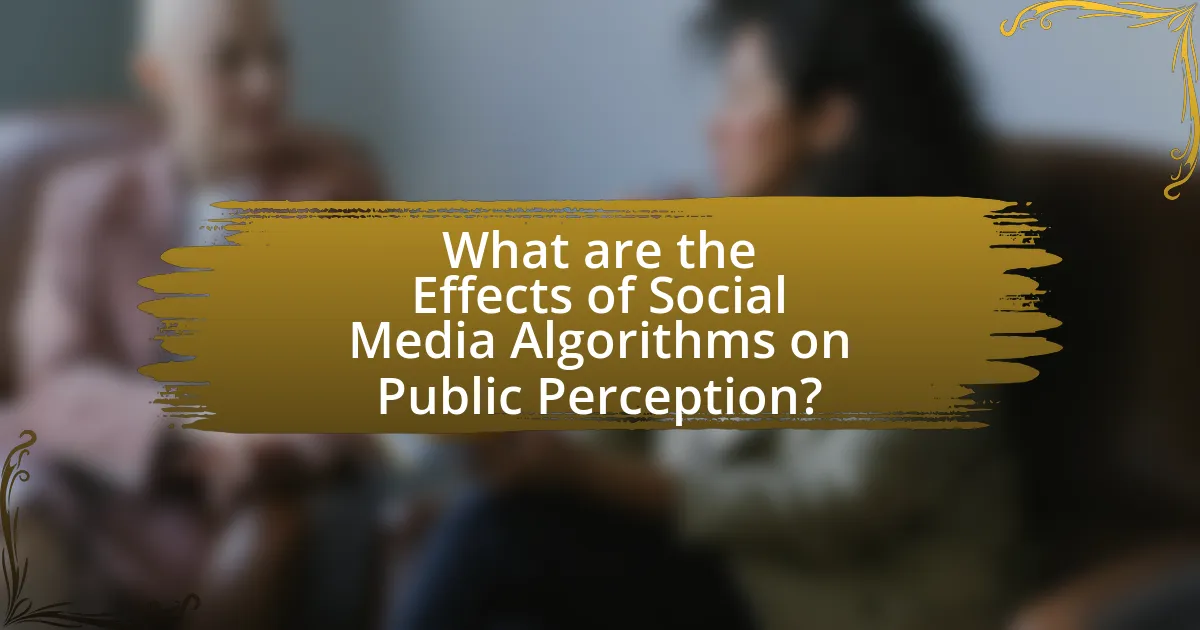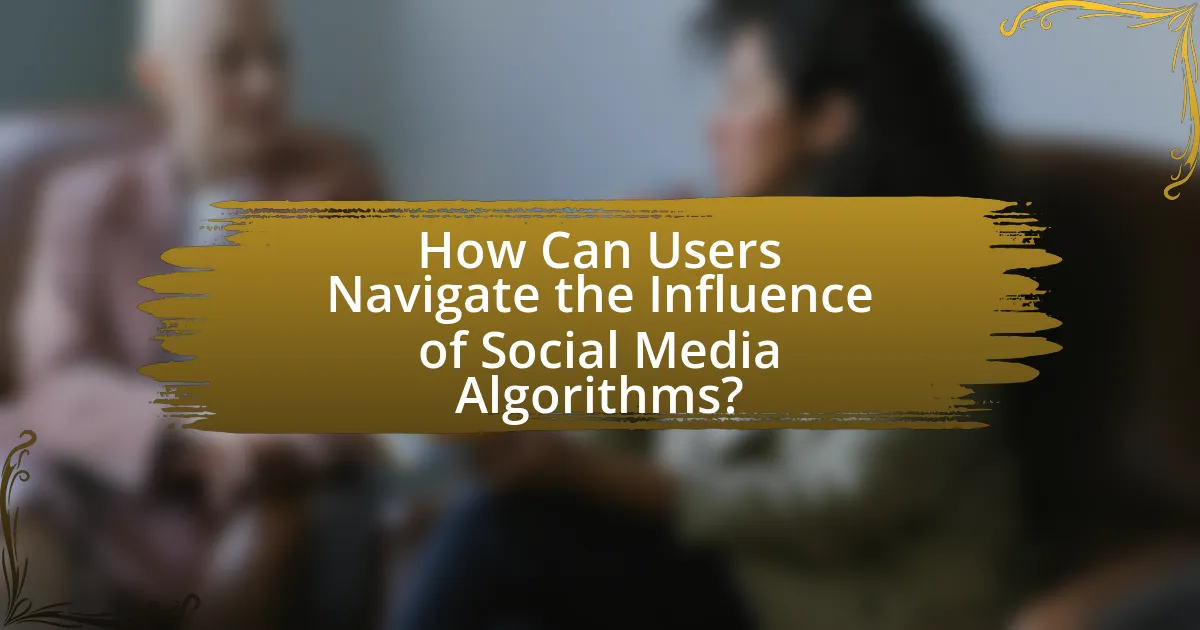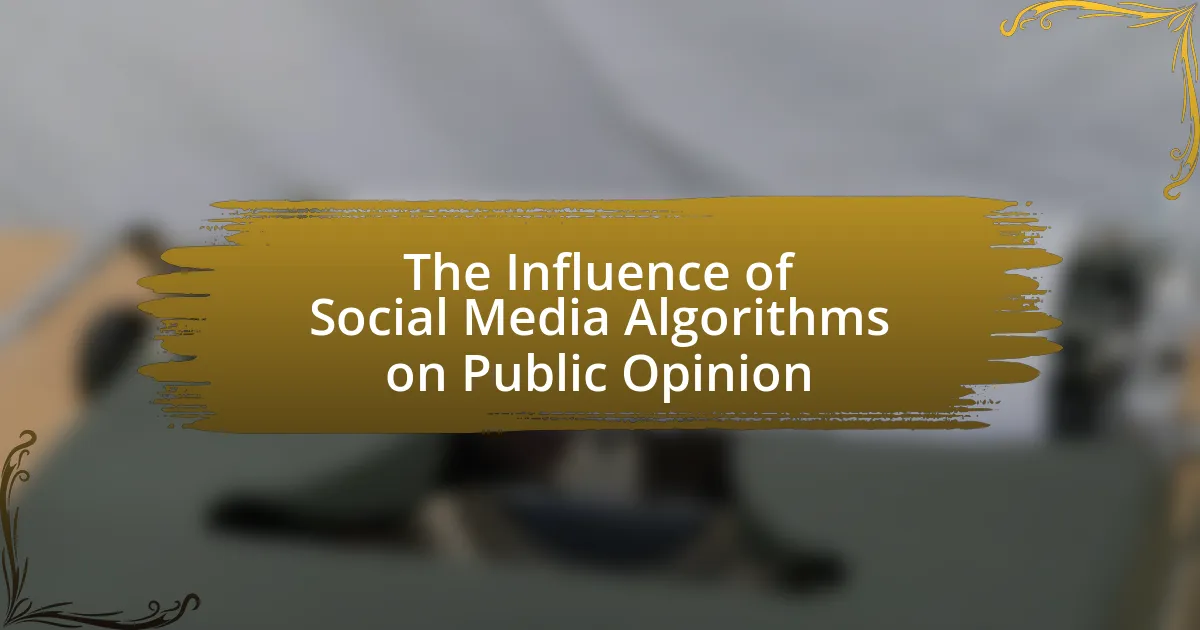Social media algorithms are mathematical formulas that determine the visibility and ranking of content based on user engagement and preferences, significantly influencing public opinion. These algorithms curate personalized feeds by analyzing user data, which can lead to the amplification of certain viewpoints while suppressing others, often resulting in echo chambers that reinforce existing beliefs. The article explores how these algorithms function, their key components, and their impact on information dissemination, user engagement, and public perception, highlighting the implications for political opinions and social movements. Additionally, it discusses strategies for users to navigate algorithmic biases and enhance their media literacy to foster a more informed engagement with diverse viewpoints.

What are Social Media Algorithms and Their Role in Public Opinion?
Social media algorithms are complex mathematical formulas used by platforms to determine the visibility and ranking of content based on user engagement and preferences. These algorithms play a crucial role in shaping public opinion by curating the information users see, often amplifying content that aligns with their interests while suppressing opposing viewpoints. For instance, a study by the Pew Research Center found that 64% of Americans believe social media has a mostly negative effect on the way things are going in the country, highlighting the significant impact these algorithms have on societal perceptions and discourse.
How do social media algorithms function?
Social media algorithms function by analyzing user data to determine which content is most relevant to individual users. These algorithms utilize machine learning techniques to assess factors such as user engagement, preferences, and interactions to curate personalized feeds. For instance, Facebook’s algorithm prioritizes posts that receive high engagement, such as likes and comments, thereby influencing what users see based on their past behavior. This targeted approach is supported by research indicating that algorithms can significantly shape user experiences and perceptions, as highlighted in studies like “The Filter Bubble” by Eli Pariser, which discusses how personalized content can create echo chambers that reinforce existing beliefs.
What are the key components of social media algorithms?
The key components of social media algorithms include user engagement metrics, content relevance, and personalization factors. User engagement metrics, such as likes, shares, and comments, determine how content is prioritized based on its interaction levels. Content relevance assesses how well a post aligns with a user’s interests and past behavior, influencing its visibility. Personalization factors tailor the content feed to individual preferences, utilizing data from user profiles and interactions to enhance user experience. These components collectively shape the content that users see, significantly impacting public opinion by amplifying certain narratives and viewpoints.
How do algorithms prioritize content for users?
Algorithms prioritize content for users by analyzing engagement metrics, user preferences, and contextual relevance. These algorithms utilize data such as likes, shares, comments, and viewing history to determine what content is most likely to resonate with individual users. For instance, platforms like Facebook and Instagram employ machine learning techniques to continuously refine their content delivery based on user interactions, ensuring that the most engaging posts appear higher in a user’s feed. Research indicates that personalized content recommendations can significantly increase user engagement, with studies showing that tailored content can lead to a 50% increase in user interaction rates.
Why are social media algorithms significant in shaping public opinion?
Social media algorithms are significant in shaping public opinion because they determine the visibility and reach of content shared on platforms. These algorithms analyze user behavior, preferences, and interactions to curate personalized feeds, which can amplify certain viewpoints while suppressing others. For instance, a study by the Pew Research Center found that 64% of Americans believe social media has a significant impact on their views about political issues, highlighting the algorithms’ role in influencing perceptions. By prioritizing engaging content, algorithms can create echo chambers, reinforcing existing beliefs and polarizing public opinion.
What impact do algorithms have on information dissemination?
Algorithms significantly shape information dissemination by determining which content is prioritized and presented to users. These algorithms analyze user behavior, preferences, and engagement metrics to curate personalized feeds, often amplifying sensational or polarizing content. Research indicates that platforms like Facebook and Twitter utilize algorithms that can lead to echo chambers, where users are exposed primarily to viewpoints that reinforce their existing beliefs, thereby influencing public opinion and societal discourse. For instance, a study by Bakshy et al. (2015) published in “Proceedings of the National Academy of Sciences” found that algorithmic filtering can significantly affect the diversity of information users encounter, ultimately shaping their perceptions and attitudes.
How do algorithms influence user engagement and interaction?
Algorithms significantly influence user engagement and interaction by personalizing content delivery based on user behavior and preferences. These algorithms analyze data such as likes, shares, and comments to curate feeds that maximize user interest, leading to increased time spent on platforms. For instance, a study by the Pew Research Center found that 64% of users feel that social media algorithms shape their online experiences by prioritizing content that aligns with their past interactions. This tailored approach not only enhances user satisfaction but also drives higher engagement rates, as users are more likely to interact with content that resonates with them.

What are the Effects of Social Media Algorithms on Public Perception?
Social media algorithms significantly shape public perception by determining the content users see, which influences their beliefs and opinions. These algorithms prioritize engagement, often amplifying sensational or polarizing content, leading to echo chambers where users are exposed primarily to viewpoints that reinforce their existing beliefs. Research indicates that algorithm-driven content curation can result in increased polarization; for instance, a study by Bakshy et al. (2015) found that Facebook’s algorithm can create filter bubbles, limiting exposure to diverse perspectives. Consequently, the effects of social media algorithms on public perception are profound, as they not only affect individual opinions but also contribute to broader societal divisions.
How do algorithms create echo chambers?
Algorithms create echo chambers by prioritizing content that aligns with users’ existing beliefs and preferences, thereby limiting exposure to diverse viewpoints. Social media platforms utilize algorithms that analyze user behavior, such as likes, shares, and comments, to curate personalized feeds. This personalization reinforces users’ pre-existing opinions, as they are more likely to encounter information that confirms their beliefs, a phenomenon known as confirmation bias. Research by the Pew Research Center indicates that 62% of social media users encounter mostly like-minded content, which contributes to the formation of echo chambers. Consequently, these algorithms shape public opinion by creating environments where dissenting perspectives are marginalized, leading to polarized communities.
What is the role of user data in forming echo chambers?
User data plays a crucial role in forming echo chambers by enabling algorithms to curate content that aligns with individual preferences and beliefs. Social media platforms analyze user interactions, such as likes, shares, and comments, to create personalized feeds that reinforce existing viewpoints. This selective exposure limits users’ encounters with diverse perspectives, thereby deepening ideological divides. Research indicates that algorithms prioritize engagement, often leading to the amplification of polarizing content, which further entrenches users within their echo chambers. For instance, a study by Bakshy et al. (2015) found that Facebook’s algorithm significantly influences the diversity of news articles users are exposed to, demonstrating how user data directly shapes the information ecosystem and contributes to the formation of echo chambers.
How do echo chambers affect diverse viewpoints?
Echo chambers significantly limit the exposure to diverse viewpoints by reinforcing existing beliefs and opinions within a closed network. This phenomenon occurs as individuals engage primarily with like-minded peers, leading to a lack of critical discourse and the dismissal of opposing perspectives. Research by the Pew Research Center indicates that 62% of social media users encounter only information that aligns with their views, which exacerbates polarization and reduces the likelihood of encountering diverse opinions. Consequently, echo chambers contribute to a fragmented public discourse, hindering constructive dialogue and mutual understanding among different ideological groups.
What are the implications of algorithm-driven content curation?
Algorithm-driven content curation significantly influences public opinion by shaping the information individuals are exposed to. This curation process can lead to echo chambers, where users are repeatedly exposed to similar viewpoints, reinforcing existing beliefs and potentially polarizing opinions. Research by the Pew Research Center indicates that algorithmic filtering can limit exposure to diverse perspectives, which may hinder critical thinking and informed decision-making. Furthermore, algorithm-driven curation can prioritize sensational or emotionally charged content, impacting the overall quality of discourse and leading to misinformation spread.
How does content curation affect political opinions?
Content curation significantly influences political opinions by selectively presenting information that aligns with users’ existing beliefs. This selective exposure can reinforce pre-existing views, leading to polarization. Research by the Pew Research Center indicates that individuals who engage with curated content on social media are more likely to encounter information that confirms their biases, which can distort their understanding of political issues. Furthermore, algorithms prioritize content that generates engagement, often amplifying sensational or emotionally charged material, which can further shape and skew public perception of political matters.
What are the consequences for social movements and activism?
Social movements and activism can lead to significant societal changes, including shifts in public policy, increased awareness of social issues, and mobilization of community support. For instance, the Black Lives Matter movement has influenced legislative reforms in policing and criminal justice across various states in the U.S. Additionally, social media algorithms amplify these movements by increasing visibility and engagement, which can result in greater public discourse and pressure on institutions. Research indicates that social media platforms can enhance the reach of activist messages, as seen in the Arab Spring, where online mobilization played a crucial role in political upheaval.

How Can Users Navigate the Influence of Social Media Algorithms?
Users can navigate the influence of social media algorithms by actively curating their content exposure and engaging with diverse viewpoints. By following a variety of accounts, adjusting their settings to prioritize chronological feeds, and utilizing features like “See First” or “Favorites,” users can counteract algorithmic biases that favor popular or similar content. Research indicates that algorithmic filtering can create echo chambers, limiting exposure to differing opinions, which can skew public perception (Bakshy et al., 2015, Proceedings of the National Academy of Sciences). Therefore, intentional engagement with a broader range of sources can help users mitigate the effects of these algorithms on their understanding of public discourse.
What strategies can users employ to mitigate algorithmic bias?
Users can mitigate algorithmic bias by diversifying their information sources and actively engaging with content that presents multiple perspectives. This strategy helps counteract the echo chamber effect often created by algorithms that prioritize familiar viewpoints. Research indicates that exposure to a variety of opinions can enhance critical thinking and reduce polarization, as demonstrated in studies like “The Filter Bubble: What the Internet Is Hiding from You” by Eli Pariser, which highlights the risks of algorithmic filtering. Additionally, users can adjust their algorithmic settings, such as opting for chronological feeds or following accounts that challenge their views, thereby promoting a more balanced information diet.
How can users diversify their information sources?
Users can diversify their information sources by actively seeking content from various platforms, including traditional media, independent news outlets, and international sources. This approach helps mitigate the effects of social media algorithms that often prioritize specific narratives. Research indicates that consuming news from a range of sources can lead to a more balanced understanding of issues, as demonstrated by a study from the Pew Research Center, which found that individuals who engage with diverse media are less likely to hold polarized views. By following different journalists, subscribing to newsletters, and participating in forums, users can enhance their exposure to multiple perspectives, thereby enriching their overall information landscape.
What tools are available to analyze algorithmic influence?
Tools available to analyze algorithmic influence include data analytics platforms, social media monitoring tools, and algorithm auditing software. Data analytics platforms like Google Analytics and Tableau allow researchers to track user engagement and behavior patterns influenced by algorithms. Social media monitoring tools such as Brandwatch and Hootsuite provide insights into public sentiment and trends driven by algorithmic recommendations. Algorithm auditing software, including tools like Fiddler and Explainable AI, enables users to assess and interpret the decision-making processes of algorithms, ensuring transparency and accountability. These tools collectively facilitate a comprehensive understanding of how algorithms shape public opinion on social media.
What best practices should users follow for informed engagement?
Users should follow best practices such as critically evaluating sources, diversifying information consumption, and engaging in respectful discourse for informed engagement. Critically evaluating sources involves checking the credibility and reliability of information before sharing or acting on it, which is essential in an era where misinformation can spread rapidly. Diversifying information consumption means seeking out multiple perspectives and sources to gain a well-rounded understanding of issues, thereby countering algorithmic biases that may limit exposure to differing viewpoints. Engaging in respectful discourse encourages constructive conversations, fostering a healthier online environment and promoting understanding among users with differing opinions. These practices are supported by research indicating that critical thinking and diverse information sources enhance media literacy and informed decision-making in the context of social media (Pew Research Center, 2021).
How can users critically evaluate content on social media?
Users can critically evaluate content on social media by assessing the credibility of the source, analyzing the evidence presented, and recognizing potential biases. Evaluating the credibility involves checking the author’s qualifications, the publication’s reputation, and the presence of citations or references. Analyzing evidence requires users to look for data, statistics, or expert opinions that support claims made in the content. Recognizing biases includes understanding the context in which the content was created, identifying emotional language, and considering alternative viewpoints. Research indicates that users who engage in these practices are more likely to form informed opinions, as highlighted in a study by the Pew Research Center, which found that critical evaluation skills significantly enhance users’ ability to discern misinformation.
What role does media literacy play in understanding algorithms?
Media literacy is essential for understanding algorithms as it equips individuals with the skills to critically analyze and evaluate the information presented by these algorithms. By fostering an awareness of how algorithms curate content, media literacy enables users to recognize biases, misinformation, and the underlying mechanisms that influence their online experiences. Research indicates that individuals with higher media literacy are better able to discern the impact of algorithmic filtering on their perceptions and beliefs, thereby enhancing their ability to navigate social media landscapes effectively.

Leave a Reply